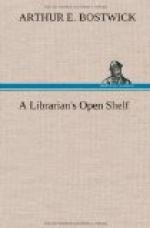There has been some effort of late to depreciate the book—to insist on its inadequacy and on the impracticality of the knowledge that it conveys. “Book-learning” has always been derided more or less by so-called “practical men”. A recent series of comic pictures in the newspapers makes this clear. It is about “Book-taught Bilkins”. Bilkins tries to do everything by a book. He raises vegetables, builds furniture, runs a chicken farm, all by the directions contained in books, and meets with ignominious failure. He makes himself, in fact, very ridiculous in every instance and thousands of readers laugh at him and his absurd books. They inwardly resolve, doubtless, that they will be practical and will pay no attention to books. Are they right? Is the information contained in books always useless and absurd, while that obtained by experience or by talking to one’s neighbor is always correct and valuable?
Many of our foremost educators are displeased with the book. They are throwing it aside for the lecture, for laboratory work, for personal research and experiment. Does this mean that the book, as a tool of the teacher, will have to go?
What it all certainly does mean is that we ought to pause a minute and think about the book, about what it does and what it can not do. This means that we ought to consider a little the whole subject of written as distinguished from spoken language. Why should we have two languages—as we practically do—one to be interpreted by the ear and the other by the eye? Could we or should we abandon either? What are the advantages and what the limitations of each? We are so accustomed to looking upon the printed page, to reading newspapers, books, and advertisements, to sending and receiving letters, written or typewritten, that we are apt to forget that all this is not part of the natural order, except in the sense that all inventions and creations of the human brain are natural. Written language is a conscious invention of man; spoken language is a development, shaped by his needs and controlled by his sense of what is fitting, but not at the outset consciously devised.
We are apt to think of written language as simply a means of representing spoken language to the eye; but it is more than this; originally, at least in many cases, it was not this at all. The written signs represented not sounds, but ideas themselves; if they were intended to correspond directly with anything, it was with the rude gestures that signified ideas and had nothing to do with their vocal expression. It was not until later that these written symbols came to correspond to vocal sounds and even to-day they do so imperfectly; languages that are largely phonetic are the exception. The result is, as I have said, that we have two languages—a spoken and a written. What we call reading aloud is translation from the written to the spoken tongue; while writing from dictation is translation from the




